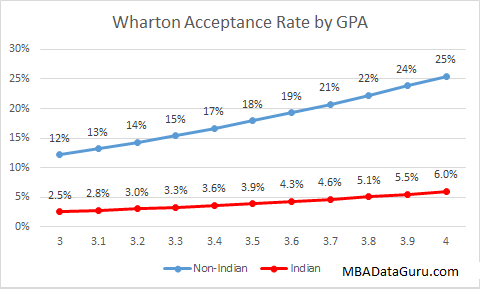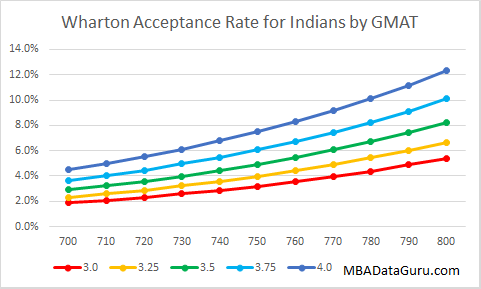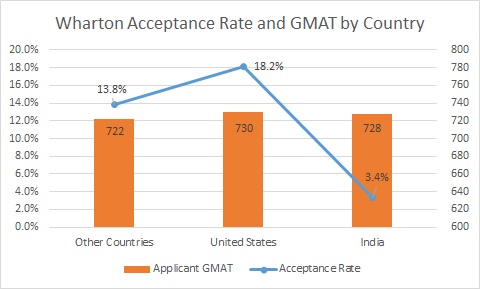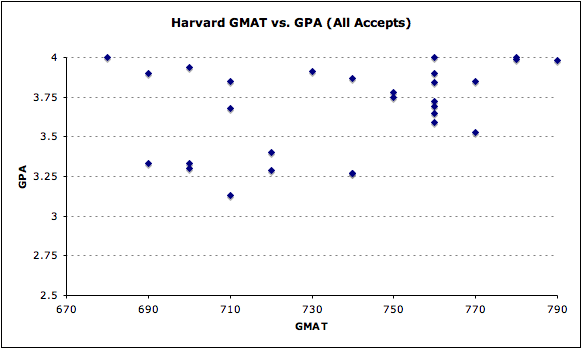Many applicants may wonder if their undergraduate major impacts their chance of getting into business school. Admissions data suggests that your college major can significantly impact your probability of getting into business school. The general trend seems to be that majors that are more dominated by women have a higher acceptance rate while industries that dominated by men had lower acceptance rates. This could be because my data does not have gender as a variable, so I could not account for it. Many people believe that women’s acceptance rate is higher than it is for men with similar credentials, but I have not found any data that proves it. Another explanation is that the female dominated majors are generally underrepresented in business school application pools, so when schools aim to diversify the class, the acceptance rates are higher for those majors. Continue reading
Tag Archives: Wharton
MBA Waitlist Acceptance Rate Analysis (with Class of 2019 data)
 One of the most frustrating parts of the MBA application process is waiting to hear back from the schools. First, applicants have to wait to hear if you will be interviewed. Next, an applicant must wait to hear if they have been admitted. Some unlucky souls will have to wait a third time on the waitlist, sometimes for up to 8 months if they are a round 1 applicant. I created this updated MBA waitlist acceptance rate analysis to provide some transparency to those who are on the waitlist. Continue reading
One of the most frustrating parts of the MBA application process is waiting to hear back from the schools. First, applicants have to wait to hear if you will be interviewed. Next, an applicant must wait to hear if they have been admitted. Some unlucky souls will have to wait a third time on the waitlist, sometimes for up to 8 months if they are a round 1 applicant. I created this updated MBA waitlist acceptance rate analysis to provide some transparency to those who are on the waitlist. Continue reading
MBA Interview Probability for top schools by GMAT and GPA
With round 2 application deadlines rapidly approaching, many applicants may wonder what their chance of getting an MBA interview with their favorite schools is. I analyzed the MBA interview probability for the top 25 schools over the past 5 years by GMAT and GPA. Unsurprisingly, for most schools the MBA interview chance increased for high GMAT and high GPA candidates. Continue reading
Military MBA Acceptance Rate Analysis
 Transitioning from the military to MBA is a fairly popular path to follow. A little over 4% of MBA applications come from military veterans. When looking at the data comparing military applicants to traditional MBA applicants, a few trends become clear:
Transitioning from the military to MBA is a fairly popular path to follow. A little over 4% of MBA applications come from military veterans. When looking at the data comparing military applicants to traditional MBA applicants, a few trends become clear:
- Military / Veteran applicants tend to be a year or two older.
- Scores for military applicants are a little lower on average, about 15 points on the GMAT and about .15 for GPA
- Military applicants on average have another year or two of work experience
- Military MBA acceptance rate is about 50% higher than the acceptance rate for traditional applicants
- Some schools have a very large advantage for military applicants while others have little to no advantage
Best Schools for Young MBA Applicants
Deciding when to start applying to business school can be a challenge. Salary increases dramatically after an MBA, but schools tend to prefer applicants with more work experience. I looked at the top 25 US MBA programs’ admission data to find the best schools for young MBA applicants in terms of chance of being admitted. I analyzed the MBA acceptance rate by age to see which schools had the smallest disadvantage for younger applicants relative to traditionally aged MBA applicants. Continue reading
Updated MBA Acceptance Rate by Round
The third round of MBA applications is notorious for having a lower acceptance rate. With the third round application deadlines approaching quickly for most business schools, you may be wondering if the stereotype about the third round is fact or fiction. I updated my analysis of MBA acceptance rate by round with the last 2 years of data and I expanded it to include Olin, Georgetown, USC, Arizona State and Vanderbilt.
This analysis was done using self-reported data from GMAT Club. Data from the class of 2014 through the class of 2018 was used because otherwise there would not be enough data for round 3 and 4 to accurately capture the acceptance rate. Continue reading
MBA Round 3 Application Deadline
It is mid March and the application season for the class of 2019 is winding down. If you plan to apply for this year, you should check the MBA Round 3 Application Deadline for the school of your dreams because it is fast approaching or already past. Also, check out the MBA acceptance rate for round 3 at the schools you are considering. Continue reading
McKinsey Emerging Scholars
For all of you soon to be MBA Students interested in consulting, McKinsey has a great opportunity for you. Apply for the McKinsey Emerging Scholars program by May 19th 2016. If you are selected to be a scholar, then you will receive a monetary award, mentorship from McKinsey consultants and an invitation to a celebratory event. Continue reading
Optimal MBA Application Number
Many business school applicants wonder how many MBA applications they should submit? In this article, I will discuss the optimal MBA application number based on real data. Deciding on your MBA application number is challenging because the more schools you apply to, the less time you have to spend on each application. On the other hand, you don’t want to put all of your eggs into one or two baskets. The data suggests that the ideal number of MBA applications is 5 to 7. For more information, check out this article on how to build your portfolio of MBA applications co-authored by Lawrence Linker and I. Continue reading
MBA Interview Acceptance Rate by GMAT and GPA
The interview is a crucial component of the MBA admission process. All top full-time MBA programs interview applicants before admitting them. Generally the MBA admissions committee is looking for two things during the interview, that you fit the culture of the school and that you have the emotional intelligence to succeed at business school. I have already looked at MBA Interview acceptance rate by itself. However, I always wondered when applying to business school if all applicants are considered equal after they have been invited to interview or does the rest of the application, like the GMAT and GPA, still matter. It turns out that it matters at some schools and not at others. Continue reading
MBA Acceptance Rate by Concentration
With the current semester just about over, next years application essay questions will be posted in the coming weeks for many schools. Round one applicants should start figuring out their story and crafting their essays. The most important essay for most schools is the question: Why get an MBA and why is [insert school name here] the right choice for you? In order to answer this question you need to have a plan for how an MBA is going to help you achieve your goals. The vast majority of MBA students are looking to switch careers. Why else pay $120,000 in tuition and give up two years of salary? If you wanted to stay in the same industry, you would probably just go for a promotion or switch companies. Continue reading
MBA Waitlist Acceptance Rate Rank
A more up-to-date analysis of MBA waitlist acceptance rate has been completed which include admissions data for the class of 2019.
At this point in the year many applicants have been placed on the waitlist for the school of their dreams. It is a frustrating experience that I personally have experienced. This articles shows the MBA waitlist acceptance rates for the top US MBA programs. The data for this analysis comes from GMATClub. These acceptance rates are meant to give a rough idea of the waitlist acceptance rate and should be taken with a grain of salt. The sample sizes vary by school; Olin, Emory and Stanford have the lowest sample sizes.
MBA Waitlist Acceptance Rate by School Rank
| US News Rank | School | Waitlist Acceptance Rate |
|---|---|---|
| 1 | Stanford | 9% |
| 2 | Harvard | 2% |
| 3 | Wharton | 6% |
| 4 | Booth | 15% |
| 5 | Sloan | 8% |
| 6 | Kellogg | 6% |
| 7 | Haas | 4% |
| 8 | Columbia | 6% |
| 9 | Tuck | 10% |
| 10 | Darden | 16% |
| 11 | NYU | 3% |
| 11 | Ross | 11% |
| 13 | Duke | 4% |
| 13 | Yale | 3% |
| 15 | Anderson | 18% |
| 16 | Cornell | 11% |
| 17 | McCombs | 8% |
| 18 | Kenan-Flagler | 46% |
| 19 | Olin | 30% |
| 20 | Tepper | 13% |
| 21 | Emory | 4% |
MBA waitlist acceptance rates ranges widely from 46% to 2% depending on the school. It tends to vary quite a bit from year to year, so these acceptance rates should only be used as a guide. For example Dartmouth’s average waitlist acceptance rate is 10%, however for the class of 2016 it was only 2%. The top ten schools on average have a slightly lower waitlist acceptance rate coming in at 8% while the next ten schools average a noticeably higher acceptance rate of 14%.
MBA Waitlist Acceptance Rate Rank
| Acceptance Rank | School | Waitlist Acceptance Rate |
|---|---|---|
| 1 | Kenan-Flagler | 46% |
| 2 | Olin | 30% |
| 3 | Anderson | 18% |
| 4 | Darden | 16% |
| 5 | Booth | 15% |
| 6 | Tepper | 13% |
| 7 | Ross | 11% |
| 8 | Cornell | 11% |
| 9 | Tuck | 10% |
| 10 | Stanford | 9% |
| 11 | Sloan | 8% |
| 12 | McCombs | 8% |
| 13 | Kellogg | 6% |
| 14 | Wharton | 6% |
| 15 | Columbia | 6% |
| 16 | Emory | 4% |
| 17 | Duke | 4% |
| 18 | Haas | 4% |
| 19 | Yale | 3% |
| 20 | NYU | 3% |
| 21 | Harvard | 2% |
The schools with the highest MBA waitlist acceptance rates are Kenan-Flagler, Olin, and Anderson. At the other end are Harvard, NYU and Yale with the lowest waitlist acceptance rates. Although NYU has the highest interview acceptance rate, it rarely accepts anyone off the waitlist.
MBA Acceptance Rate by Application Round
Some business schools have roughly the same acceptance rate during all rounds while others see a significant drop off in later rounds. With applications for round 3 due in the next month or two, this analysis may help you decide which schools to focus on and which to avoid. Here is a list of the top 20 schools’ MBA acceptance rates by application round. The data for this analysis came from GMAT Club, which may be a biased sample. People on GMAT Club tend to have higher GMAT scores than the general applicant pool, so the acceptance rate can be significantly higher for some schools. The acceptance rates are meant to give you an idea of the relationship between rounds, not the absolute acceptance rate. These numbers are raw and not adjusted for other variables such as GMAT and GPA.
MBA Acceptance Rate by Round
The first table is MBA acceptance rates by round ordered by school ranking. The acceptance rates that have a star next to them means that the sample size is very small and might not be very accurate.
| US News Rank | School | Round 1 | Round 2 | Round 3 | Round 4 |
|---|---|---|---|---|---|
| 1 | Stanford | 8% | 5% | 2% | - |
| 1 | Wharton | 19% | 16% | 0%* | - |
| 1 | Harvard | 12% | 6% | 4% | - |
| 4 | Booth | 29% | 25% | 15% | - |
| 5 | MIT | 16% | 11% | - | - |
| 6 | Kellogg | 26% | 23% | 20%* | - |
| 7 | Haas | 17% | 17% | 6% | |
| 8 | Columbia | 23% | 20% | - | - |
| 9 | Tuck | 28% | 29% | 22% | 9% |
| 10 | NYU | 29% | 27% | 21% | |
| 11 | Ross | 41% | 42% | 38%* | - |
| 11 | Darden | 32% | 33% | 16% | - |
| 13 | Yale | 24% | 27% | 9% | - |
| 14 | Duke | 31% | 33% | 21% | - |
| 15 | McCombs | 38% | 36% | 28% | - |
| 16 | Anderson | 26% | 34% | 9% | - |
| 17 | Johnson | 39% | 36% | 37% | - |
| 18 | Tepper | 24% | 38% | 43% | - |
| 19 | Kenan-Flagler | 36% | 40% | 60% | - |
| 20 | Emory | 26% | 40% | 37% | - |
Schools with Significantly Lower Round 3 Acceptance Rate
Many of the top 20 MBA programs have significantly lower acceptance rates in round 3 to the point where it is better to wait until next year to apply. Harvard, Stanford and Wharton, the number one ranked schools, have a large decrease in acceptance rate for round 3. Only 2% to 3% of applications for these schools are in round 3 because everyone knows that acceptance rates are so low. Haas, Yale, Duke, UVA and UCLA also see a significant drops in round 3 admissions compared to earlier rounds. Dartmouth has a respectable round 3 acceptance rate of 22%, but a very low 9% chance of admission for round 4.
Schools with Similar or Higher Round 3 Acceptance Rate
While many schools have a lower acceptance rate for round 3, there are several schools that don’t have a drop off in response. Ross, Cornell, and Emory all have similar admission odds for the third round, while Tepper and UNC actually have a higher acceptance rate for round 3.
Round 3 MBA Acceptance Rate Ranking
This is the the same table as the first one but ranked by round 3 acceptance rate from highest to lowest. Some schools have a round 4 that I did not include, because the sample size was too small. I combined round 4 applications with round 3 except for Tuck because Dartmouth actually had a large number of round 4 applicants.
| Round 3 Rank | School | Round 1 | Round 2 | Round 3 | Round 4 |
|---|---|---|---|---|---|
| 1 | Kenan-Flagler | 36% | 40% | 60% | - |
| 2 | Tepper | 24% | 38% | 43% | - |
| 3 | Ross | 41% | 42% | 38%* | - |
| 4 | Johnson | 39% | 36% | 37% | - |
| 4 | Emory | 26% | 40% | 37% | - |
| 6 | McCombs | 38% | 36% | 28% | - |
| 7 | Tuck | 28% | 29% | 22% | 9% |
| 8 | NYU | 29% | 27% | 21% | |
| 8 | Duke | 31% | 33% | 21% | - |
| 10 | Kellogg | 26% | 23% | 20%* | - |
| 11 | Darden | 32% | 33% | 16% | - |
| 12 | Booth | 29% | 25% | 15% | - |
| 13 | Yale | 24% | 27% | 9% | - |
| 13 | Anderson | 26% | 34% | 9% | - |
| 15 | Haas | 17% | 17% | 6% | |
| 16 | Harvard | 12% | 6% | 4% | - |
| 17 | Stanford | 8% | 5% | 2% | - |
| 18 | Wharton | 19% | 16% | 0%* | - |
| 19 | MIT | 16% | 11% | - | - |
| 19 | Columbia | 23% | 20% | - | - |
The most surprising number is UNC Kenan-Flagler’s round 3 acceptance rate of 60%, which is significantly higher than that of round 1 and 2. I looked at the GMAT and GPA for each round to see if they would explain the high admissions in round 3, however they were both slightly lower than other rounds. I can’t explain why UNC round 3 acceptance rate is so high, but it is a great school to apply to in the third round.
By request, below is the GMAT, GPA and age for Harvard and Booth by round. Round 3 data does not have a ton of data, so take this with a grain of salt.
| School | Variable | R1 | R2 | R3 |
|---|---|---|---|---|
| Booth | GMAT | 735 | 739 | 728 |
| Booth | GPA | 3.61 | 3.62 | 3.58 |
| Booth | Age | 27 | 28 | 29 |
| Harvard | GMAT | 735 | 728 | 720 |
| Harvard | GPA | 3.61 | 3.57 | 3.54 |
| Harvard | Age | 27 | 27 | 27 |
* Sample size is 30 or fewer applications.
Wharton MBA Interview Questions and Preparation
 Wharton is tied for the number one business school in the world. If you are fortunate to be invited to interview for a spot in Wharton’s MBA program then you are very lucky. Unfortunately, only 47% of applicants interviewed for the Wharton MBA program will be accepted into the school. Given the lower than 50-50 chance of acceptance, you should prepare as much as possible for your Wharton interview. This guide will walk you what to expect during your team based discussion (TBD), your individual Wharton MBA interview as well as what are the most common questions asked during the interview.
Wharton is tied for the number one business school in the world. If you are fortunate to be invited to interview for a spot in Wharton’s MBA program then you are very lucky. Unfortunately, only 47% of applicants interviewed for the Wharton MBA program will be accepted into the school. Given the lower than 50-50 chance of acceptance, you should prepare as much as possible for your Wharton interview. This guide will walk you what to expect during your team based discussion (TBD), your individual Wharton MBA interview as well as what are the most common questions asked during the interview.
What to Expect in Wharton MBA Interview
There are two components to a Wharton interview. First you will participate in the TBD, then you will have a one on one interview, typically with a second year MBA student who watched you during the TBD. I recommend showing up to your interview at least 30 minutes early. This will give you a chance to meet as many of the applicants as possible. Hopefully you will meet several of the applicants who will be in your team based discussion, which will make working with them easier.
The TBD will last roughly 35 minutes and there will be 4 or 5 other applicants in the interview with you. There will also be 2 second year MBA students observing you. One of the two observers will be your one on one interviewer. Each prospective student will be given 1 minute to introduce them-self and their idea for the prompt. Take notes during the prompt and probably throughout the entire discussion. Make sure you know everyone’s name or you will look like an idiot, so write everyone’s name down. After the introductions are over you have another 30 minutes to solve the problem.
If your idea is selected then great, if not then don’t worry, just play along with the group. This isn’t an idea contest, it is an opportunity to see how your interact in a group. You need to show that you can work well in a group. If you act like a jerk and try to force your idea down everyone’s throat then you will not get into Wharton.
If possible try to show leadership traits. This can be by proposing an agenda for the discussion. This could be assigning roles such as time keeper and note taker. Be sure to talk but not too much. And do not interrupt other applicants.
Wharton MBA Interview Questions
The personal interview will last 10 to 15 minutes and will be conducted by one of the two MBA2’s who observed your TBD. You will typically be asked 4 questions, but it can range from 2 to 6. Here is a list of Wharton interview questions as well as the probability that you will be asked it during the one on one interview. The Wharton MBA interview questions were collected from Clear Admit.
- (83%) How do you think the discussion went?
- (42%) Walk me through your resume / tell me about yourself.
- (42%) Did your behavior in the TBD reflect how you normally are?
- (25%) Why Wharton?
- (25%) Do you have any updates to your application?
- (25%) What clubs would you participate in here at Wharton?
- (17%) What is something that your group could have done better?
- (17%) Who I would want and NOT want on my team?
I found the the who you would not want on your team question especially difficult because I wasn’t expecting it. Even though it is a rare question, make sure you have an answer. Good luck in your Wharton MBA interview and be sure to check out my guide to preparing for MBA interviews.
MBA Interview Acceptance Rate Rankings
So you have just been invited to interview at the MBA school of your dreams. Obviously this raises your chance of getting in, but by how much? In general, top ten schools have lower MBA interview acceptance rates while schools ranked 11 to 20 have a higher acceptance rate for applicants who were interviewed.
MBA Interview Acceptance Rate by Rank
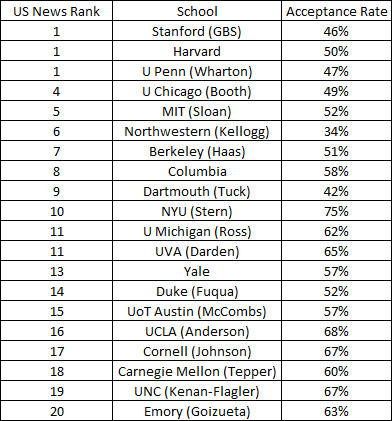
Interview acceptance rate for Stanford, Harvard, Wharton, Booth, MIT, Kellogg, Hass, Columbia, Dartmouth, NYU, Ross, Darden, Yale, Duke, McCombs, Anderson, Cornell, Tepper, Kenan-Flagler, Emory
The acceptance rate ranges from 34% to 75% for schools in the top 20. The average MBA interview acceptance rate for the top 10 is 50% and it is 62% for schools ranked 11 to 20.
MBA Interview Acceptance Rate Rankings from Highest to Lowest
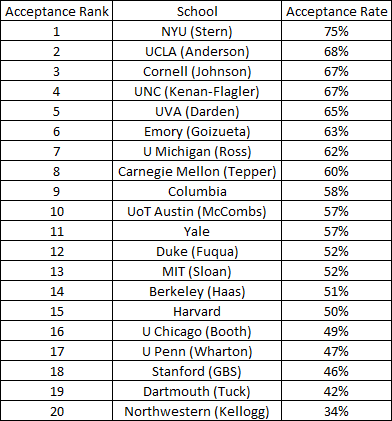 NYU jumps out as the highest acceptance rate by a wide margin. If you have been selected to interview at Stern then you can prepare to open a bottle of champagne because you are probably going to business school. No other school in the top 10 has an interview acceptance rate above 60%.
NYU jumps out as the highest acceptance rate by a wide margin. If you have been selected to interview at Stern then you can prepare to open a bottle of champagne because you are probably going to business school. No other school in the top 10 has an interview acceptance rate above 60%.
On the other end of the spectrum is Kellogg and Tuck with the lowest acceptance rates. These two schools will allow anyone who visits campus to interview, so it is not surprising that they admit significantly fewer applicants who are interviewed. Most of the top 10 schools have an acceptance rate clustered between 46% and 51%.
Duke has the lowest acceptance rate for a school not in the top 10 at 52%. The rest of the schools range from 57% to 68%,
Good luck and don’t forget to prepare for your MBA interviews!
Follow Up on Wharton Acceptance Rate for Indian Applicants
Last week I posted an article discussing the Indian application disadvantage at Wharton. I received a request to go into more detail about how GMAT impacts the Wharton acceptance rate for Indian applicants. Given that only 5% of applicants identified as Indian and the acceptance rate is low, I don’t have enough data to look at that relationship in isolation. However, I have built a model that can predict what that relationship would be for Indian applicants based off of data from other Wharton applicants.
Wharton Acceptance Rate by GMAT
As you can see, my model predicts that there is a relationship between GMAT and the Wharton acceptance rate. This acceptance rates in the graph assumes a GPA of 3.54, which is the average for Wharton applicants. As you would expect, the higher the GMAT score, the higher the chance of getting in. Unfortunately, even with an 800, the forecast acceptance rate is still less than 10% for Indian applicants. 
Wharton Acceptance Rate by GPA
I decided to also look at the relation ship between GPA and acceptance rate as well. Similar to GMAT, higher GPAs increase your chance of acceptance. For the graph below I used the average Wharton GMAT score of 728 to calculate the acceptance rate. Even for candidates with a 4.0 GPA, they only have an acceptance rate of 6%.
After that I made a graph displaying the relationship between GMAT and GPA on acceptance rate for Indian applicants. With a 4.0 GPA and 800 GMAT, the acceptance rate increased to 12%, but that is still very low for such a qualified candidate.
The final question to answer is which is more important to Wharton, GMAT or GPA. I already had suspicions that Wharton cared more about GMAT than GPA, and this analysis confirmed it. I looked at the average candidate (both Indian and non-Indian) then compared the average acceptance rate to the acceptance rate one standard deviation above and below for both GMAT and GPA.
 As you can see the slope for the line is steeper for the GMAT than for GPA. What this means is that a candidate who score one standard deviation above average for GMAT will be rewarded more than a candidate who has a GPA one standard deviation above average. Similarly a candidate will be punished more for having a low GMAT. This suggests that GMAT is more important to Wharton than GPA.
As you can see the slope for the line is steeper for the GMAT than for GPA. What this means is that a candidate who score one standard deviation above average for GMAT will be rewarded more than a candidate who has a GPA one standard deviation above average. Similarly a candidate will be punished more for having a low GMAT. This suggests that GMAT is more important to Wharton than GPA.
The data used to make this post came from GMAT Club and included applicants from 2012 through 2014.
Indian Application Disadvantage at Wharton’s MBA Program
Recently I discovered an Indian application disadvantage at Wharton’s MBA program while reviewing their admissions data. I have been busy over the past few months at business school and haven’t been able to post. I am attending NYU Stern school of business and loving it. I have a little bit of free time over Thanksgiving break so I decided to make a little progress towards building my MBA admission calculator. I started by analyzing Wharton’s admission data because I have far more data available for Wharton compared to other schools. This makes it easier to find statistical significance in the model. For example, there are 1,093 Wharton applicants verses 498 NYU applicants. I built a beta version of a model to predict admissions into Wharton, but plan to spend a lot more time working on it before I release it on this website.
The Indian Application Disadvantage at Wharton
In building the logistic regression, I found that the only three variables had statistic significance, including GPA, GMAT and whether the applicant was from India. I was shocked to find a significant Indian application disadvantage, the acceptance rate for Indians was 3.4% compared to 18.2% for Americans and 13.8% for non-Indian Internationals.
The difference between American and non-Indian acceptance rates was not statistically significant. However, the Indian acceptance rate difference was significant, with a confidence interval of 0% to 8%. This means we can be about 95% sure that the Indian acceptance rate is equal to or lower than 8%. For this analysis I excluded all entries that were missing both GMAT and GPA. If I had included these applicants who didn’t share their scores, then the Indian acceptance rate would have dropped to 2.8%.
I don’t know why the acceptance rate for Indian applicants is lower despite similar GPAs and GMAT scores. It could be due to trouble writing application essays or some other explanation, but I think this matter needs to be looked at closer.
Protein Folding and Gamification
Right now I am taking a class through Coursera taught by a Wharton professor Kevin Werbach called Gamification. Gamification is the process of adding game like elements to non-game activities. Gamification makes those non-game activities more fun and engaging. In one lecture, professor Werbach talkes about a gamified research tool called Foldit. This tool is used to help solve protein folding problems.
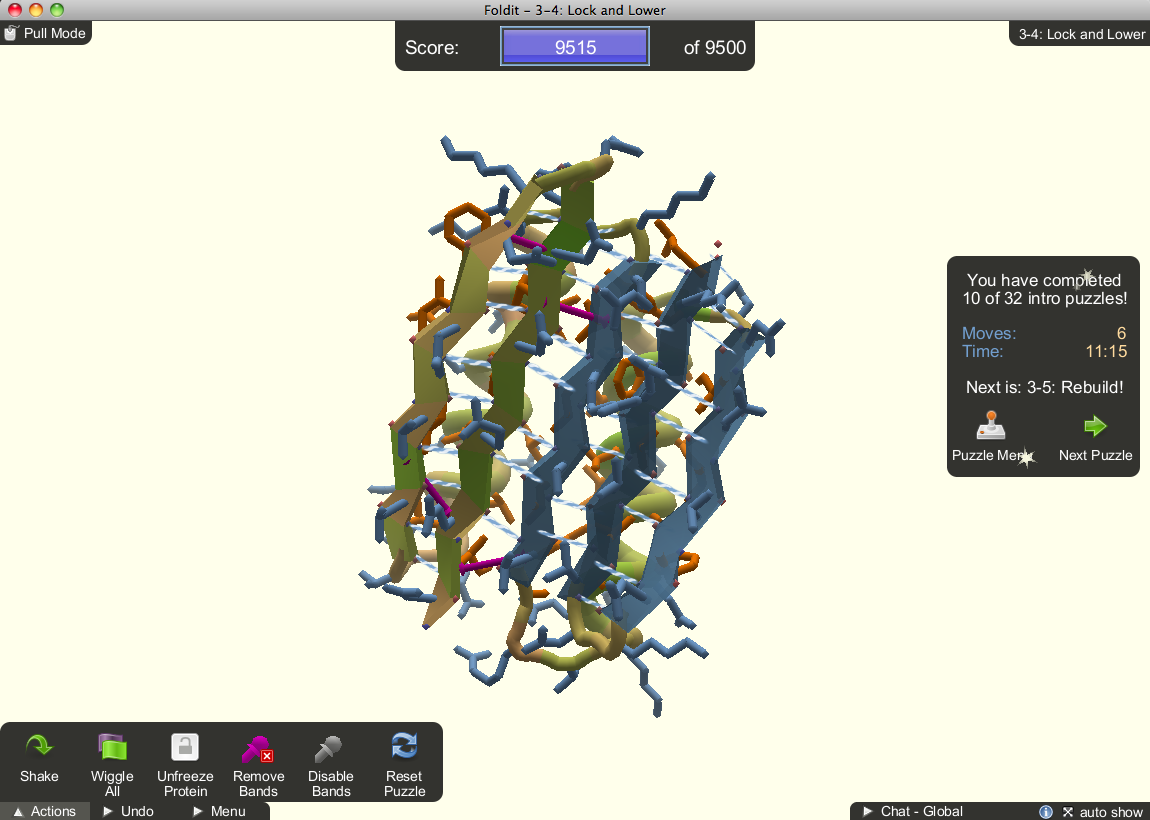
What is Protein Folding
Proteins folding can be used to help understand how the body works and assist in finding cures for diseases such as HIV and cancer. Solving protein folding is an incredibly complicated problem and requires expensive supercomputers. Interestingly, human intuition is actually better at solving these complex problems than supercomputers. Researchers at the University of Washington decided to tap into the power of the human mind to solve these problems. The researchers turned protein folding into a game. Players score points for finding the best way to fold a protein.
In three weeks the gamers were able to solve problems that researchers had been working on for ten years. They helped to find targets for drugs to neutralize the AIDs virus.
My Experience Protein Folding
I downloaded and played Foldin. It is an extremely unique game. I actually really enjoy it. It gets difficult quickly. I finished the first 10 levels without major problems but am getting stuck on the 11th. In order to beat a level, you need to reach a target score. If you are really close to the target but can’t quite get there, it is really frustrating to start over. I don’t think I have solved any diseases yet because I am still on the 32 introductory levels that teach you the game.
Wharton GPA Impact on MBA Acceptance Rate
I posted an updated Wharton acceptance rate analysis which is more accurate than this article. It shows how GPA and GMAT affect your odds of admissions.
When applying to a top MBA program, GMAT and GPA are important parts of the application. As one would expect from a top MBA program, at Wharton GPA has a large impact on your chances of admission. The question is how much does your undergraduate GPA affect your chance of admission. I analyzed the acceptance data from the past two and half years at GMAT Club to see how much GPA impacts acceptance rate. Unlike Harvard where there is little benefit from GPA until 3.8 or higher, at Wharton the acceptance rate generally increases as the undergraduate GPA rises.
At Wharton GPA Increases Chance of Admission
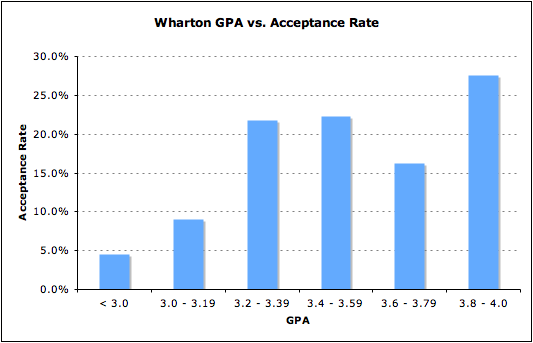 You can clearly see that acceptance rate is lowest below 3.0 and highest in the 3.8 to 4.0 range. There is a slight dip in the 3.6 to 3.79 GPA range. I took a closer look and it appears to be because more applicants in this GPA range worked in industries that Wharton does not value. There are more applicants in the 3.6 to 3.79 range that work in Government and Mutual Funds and fewer in Military and Venture Capital, which are industries that Wharton seems to prefer.
You can clearly see that acceptance rate is lowest below 3.0 and highest in the 3.8 to 4.0 range. There is a slight dip in the 3.6 to 3.79 GPA range. I took a closer look and it appears to be because more applicants in this GPA range worked in industries that Wharton does not value. There are more applicants in the 3.6 to 3.79 range that work in Government and Mutual Funds and fewer in Military and Venture Capital, which are industries that Wharton seems to prefer.
Higher GPA does appear to increase the chance of an applicant being admitted to Wharton, but the slope is not as steep as I would have expected. Unfortunately for some, GPA is stuck in stone. Applicants who hope to increase their chance of admissions need to focus on GMAT to increase their odds. Luckily, data suggests that very high GMAT scores significantly increase the odds that Wharton will accept an applicant. If an applicant studies hard for the GMAT, then a high GMAT score is highly likely achievable. There are many companies that offer GMAT preparation which will increase your chance of admission.
Wharton does not publish statistics on GPA for us to analyze. However, we can look at what the average GPA is in my data set. The mean GPA for accepts at Wharton in my dataset is 3.61 GPA with a middle 80% GPA in the range of 3.23 to 3.94. The mean Wharton GPA of 3.61 is lower than the mean Harvard GPA of 3.66.
Harvard GMAT vs. GPA Comparison
I have posted a more up to date Harvard Business School acceptance rate analysis which is based on GPA, GMAT and application round.
Word is that Harvard will take a chance on applicants who have low scores, but impressive accomplishments. Lets see if Harvard lives up to its reputation.
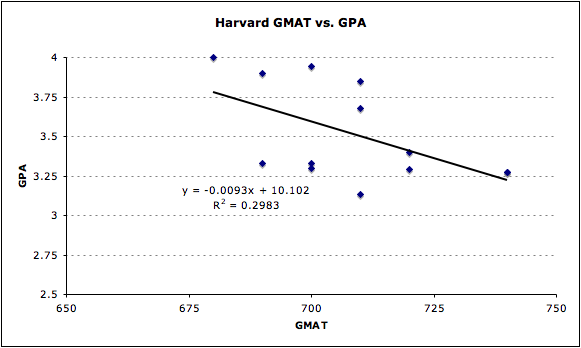
As you can see the slope for Harvard is much steeper than for the other schools. The slope of -.0093 means that Harvard would look at an application with a 750 GMAT and 3.0 GPA similarly to a 650 and 3.93. This result is interesting, it shows that on the margin Harvard is weighs GMAT very strongly, however, the marginal Harvard GMAT scores are lower than other schools. Harvard is willing to take a chance on a low GMAT, but you better have a damn high GPA to make up for it.
Harvard GMAT vs. GPA All Accepts
It is interesting to look at the total accepts instead of just the accepts on the margin. As you can see below, Harvard seems to be completely missing the population of students with low GPA and really high GMAT. I guess the admissions committee isn’t interested in students who slacked in undergrad and tried to make up for it with GMAT. I find that odd given Harvard’s reputation for grade inflation. They say that the hardest part of Harvard is getting in.
The median Harvard GMAT score is 730. It is interesting that Harvard posts the median GMAT score instead of mean score like other schools. You can hide some very low GMAT scores by only posting a median. I would venture a guess that Wharton’s mean GMAT score, at 725, is higher than Harvard’s GMAT mean. After all, Harvard did accept a person with a 550 GMAT score last year. That has to be bringing down the average.
Check out how some of the other schools weigh GMAT vs. GPA:
Methodology: The scatterplot represents the 50% of applicants who are accepted with the lowest GMAT and GPA. It isn’t helpful to look at the top 50% of applicants because those are not the marginal candidates who barely got in. I occasionally will remove very low outliers because those candidates may have been admitted due to very strong connections that most applicants don’t have. I never remove more than 5% of the total accepted students as outliers. The slope of the scatterplot demonstrates the point at which the school is indifferent to GMAT vs. GPA. The data for this analysis comes from GMAT Club.


